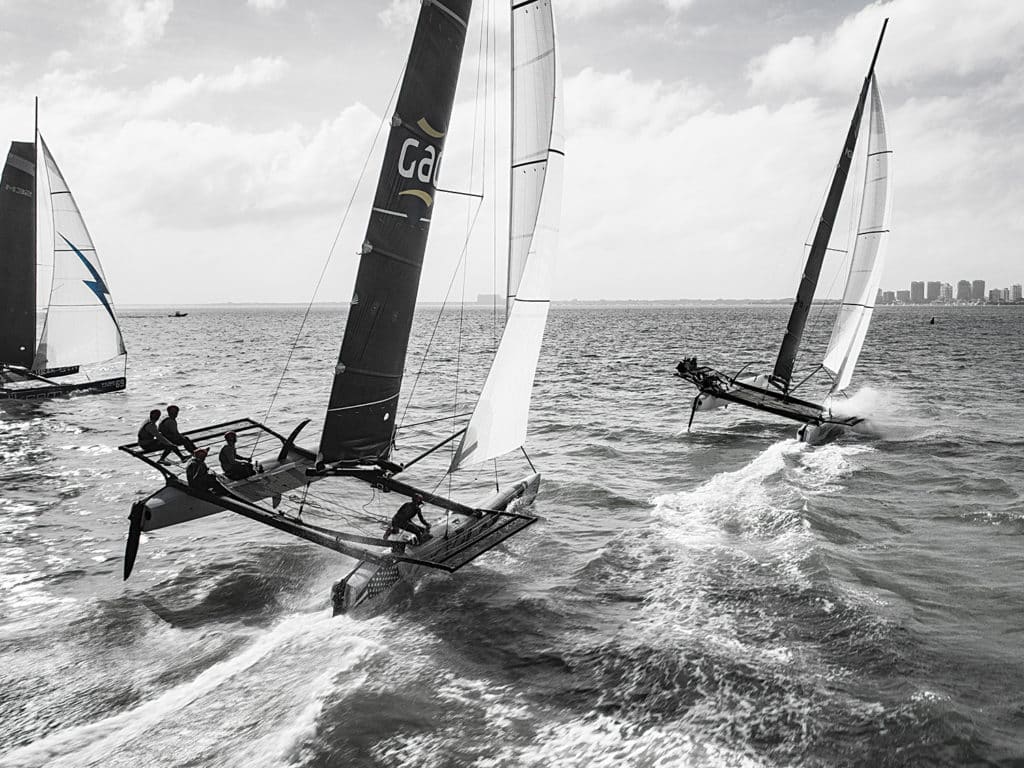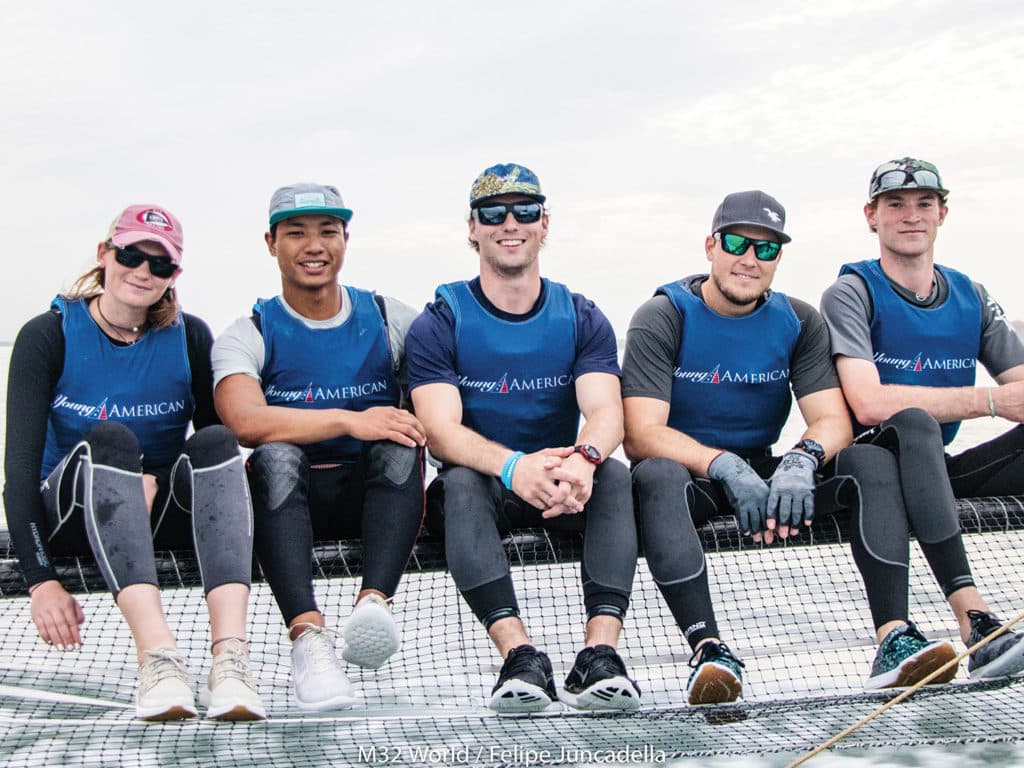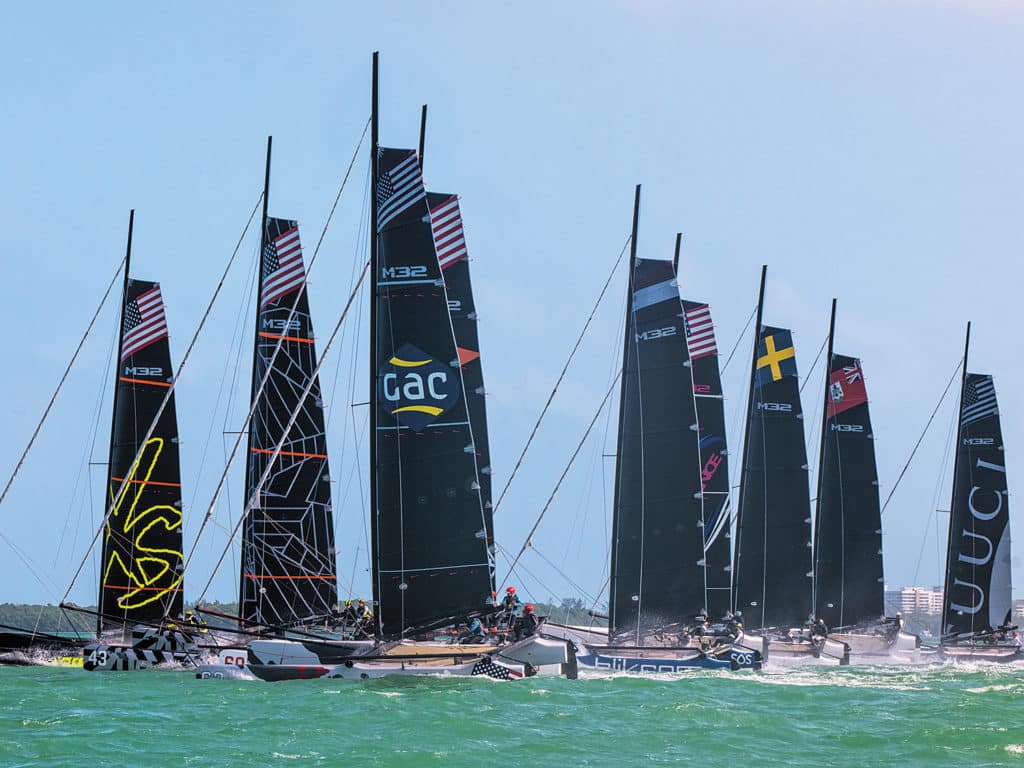
We’re now 10 days into our immersion in the M32 catamaran scene. We’re walking down the dock at Shake-A-Leg on the second day of the M32 Miami Winter Series. The boys—Gordon, Chris, Riley and Key—all sporting their Young American team shirts, stroll past the other perfectly polished and vinyl-wrapped race boats. I can sense their anticipation and excitement growing as we make our way past. As I walk behind them, I notice a little more pep in their step, the soreness from the previous day’s racing barely noticeable.
Berthed at the far end of the dock is our boat—two stark-white hulls with light-blue decking and black trim. The boat is owned by Sail Newport, the community sailing organization in Newport, Rhode Island, so it’s not technically “ours,” but we’re campaigning it for the winter, thanks to the support from Sail Newport and the M32 Class Association. It’s been a long time coming with putting it all together and getting the boat down south.
We’re the “youngsters” of the class—a team of college students and recently graduated kids, looking to experience, train and compete in one of the top high-performance classes in the world. We’re sailing under the banner of the Young American Sailing Academy, which started in 2013 as a way to kick-start a new generation of offshore sailors. Highlights of the Academy’s achievements include racing in the 2016 and 2018 Newport Bermuda Races, where the team received line honors in 2016 on the Tripp 41 High Noon and competitively sailed the Reichel/Pugh 63-footer Gambler in 2018.
Some of us are recent additions to the Young American program, so we’ve had only a few days of practice as a squad, but we’ve quickly bonded into a tightknit team. Key Becker, who is the forwardmost guy on the M32’s rack, is our main trimmer. He’s tall and lanky and has bleach-blond hair that sticks out from his pink helmet. He shares a similar big-boat background to myself and sails for the College of Charleston’s Offshore Team. He’s my older brother, and yes, he has been suspiciously nicer since this boat came our way.
Behind Key is Riley Freeman, our floater. Riley is a big-boat sailor and surfer from California who is studying at the University of San Diego. He is the muscle on our boat and brings the laid-back West Coast vibe to the team. He matches Key with the long blond hair, making them the perfect rack buddies. Next aft on the rack is Gordon Gurnell, who skippers at Connecticut College and grew up sailing dinghies in Newport, Rhode Island. In his hand is the traveler line, the “big‑guy” job on the boat.

Chris Manson-Hing is on gennaker trim. Chris graduated from Hobart and William Smith Colleges, and is the one with experience in multihull and skiff sailing on the boat. He’s small, but he’s fierce.
As for me, I’ve come up through a wide variety of monohull big boats. I define myself as a driver, but I can run around and fill any position on most boats. I also grew up sailing dinghies and now sail for Boston University, and until our first event with the M32 class—this past summer’s Midtown Cup in Newport—I’d never been exposed to multihull sailing, or much of skiff sailing, for that matter. As you can imagine, the M32 came with a vertical learning curve for all of us. After only a few days of sailing on the boat, I’ve learned it requires a strong helm and a playful hand. The balance of the boat and the rate of acceleration when it’s loaded is far different than anything I’ve ever experienced.
As we arrive at our boat at the end of the dock, we prepare for the day ahead. The wind is drowned out by the latest recording of a Phish concert playing from a little blue speaker clipped to the rack. It’s our team anthem now, thanks to Key and his obsession with the band. We tackle the morning work list: Tighten the trampoline, put in the boards, situate the lunch, check the spares kit, and so on. Because we’ve had two days of practice canceled this week on account of too much wind, we’ve had plenty of dock time, making us a well-oiled machine when it comes to boatwork.
Soon after, as we pull off the dock and head out of the harbor, waves crash over our bows as we slam through the chop. It’s blowing a solid 18 knots, with gusts in the low- to mid-20s —conditions we have sailed in only once before. As we hoist the main, anticipation is building. Gordon, Riley and Key line up on the main halyard, as if they’re about to start a game of tug of war. They’re waiting for the “ready to go up” from Chris. As they hear the call, they lean in to every pull as the bolt rope zips up the mast track.
Once the main is up and the boys are ready to play, we take off for our pre-race practice. We head upwind but look for the first opportunity to turn downwind and get the gennaker unfurled. When it’s go time, I reach behind me, clip the tiller extension onto the tiller bar, pop up onto the back beam, and lock my front foot under the traveler.
Chris counts, “Three, two, one,” and I steer the boat down into a bear-away set. The gennaker rolls out, Riley leaps to the winch, puts his head down and spins the handle like a madman.

Our next move is a furl-and-jibe. Riley jumps off the rack as Chris prepares the gennaker sheet to be eased. Key and Gordon are waiting, ready to bounce into action. The call is made, and Key darts across the boat, bouncing his way toward the leeward hull. I watch the gennaker begin to furl, and then, unnaturally, I feel the hull beneath me begin to force itself out of the water. Both bows are fighting gravity and lift skyward.
The windward board must have been put down in preparation for jibe, but with both boards down, there’s too much lift. The boat pops a wheelie before the bows come crashing down with a thud and big splash. The boat then settles, as do we. The mistake with the board drop is identified—one of the many lessons we’ll learn.
For each race, we set up one step behind the fleet, hanging back and being conservative by not engaging with the more-experienced teams. But when the flag skies, signaling the last race of the day, our hearts are beating a little faster. I think we’re all feeling that it’s time to be closer to the fleet. We’re excited and more comfortable with this weirdly bouncy, wet and jerky boat.
Each race begins with a reaching start, followed by a power reach to a bear-away mark, transitioning the race into a downwind leg. That first leg is the most intense part of the race, and the outcome typically determines one’s positioning for the rest of the race.
“This is the race, guys,” Chris, our trimmer and tactician, yells. “Let’s get closer.”
As the countdown continues, we place ourselves in the same “safe zone” we’ve been playing in the whole weekend—to windward of the rest of the fleet, just below our layline to the race-committee boat. This time, we tuck ourselves that much closer to the pack. We want to play.
I pull on the tiller, the bows turn down, and I aim toward the orange triangle in the distance. Water rushes past the leeward hull, and the windward hull pops out and starts to fly. Expressions turn more serious, and the boys start howling, “Coms.” We are in the mix. We have a boat to leeward, and we are on the tail of the fleet.
Before we know it, the orange turning mark is upon us. “Hold on deploy,” Chris yells as he watches the leeward boat scream past the mark. Once we’re clear of their stern: “Deploy in three, two, one.”
I turn the boat down hard, the apparent wind builds, and I jolt the boat back up to get the hull flying, and we quickly watch the speedometer on the display climb into the mid-20s.
Someone on the rack screams: “Yeah, buddy! Let’s get her ripping.”
Shortly after boats ahead flop onto the other jibe, we pick our line and prepare to jibe ourselves. Chris, when happy with our positioning, yells out, “Jibing in three, two, one.”
Similar to earlier, Riley jumps off the rack and reaches for the furling line. Key and Gordon wait until the boat starts to turn. The gennaker wraps around itself, and the boys are already on their feet. I finish the turn, and the boys wrap up their jobs before getting back on the rack. Once the gennaker starts to make its way in, I turn the boat up and pop a hull.
The fleet leaves us in a frothy sea of wakes, but we keep working hard to stay as close as possible. Being the new team on the course, we have a lot to learn, but the learning has been the most fun and insane sailing we’ve ever been exposed to. The M32 catamaran is challenging and physically demanding, but we are determined to master this beast. As we cross the finish line of our last race, Key speaks for all of us when he says, “I’m officially in love with this boat.”









